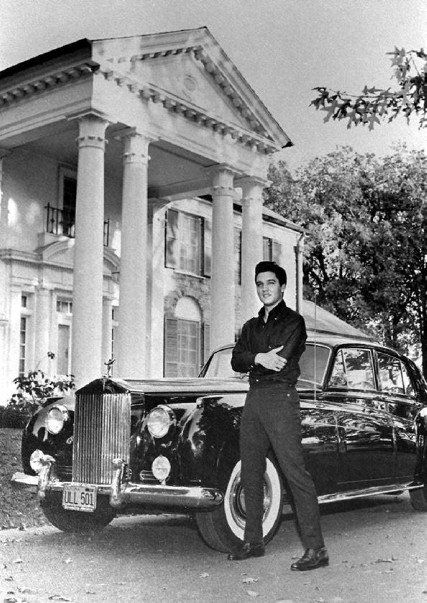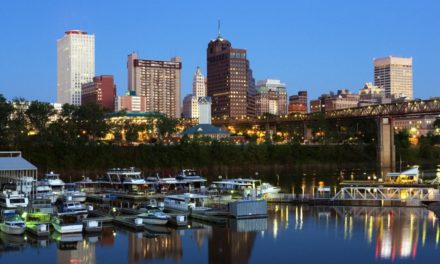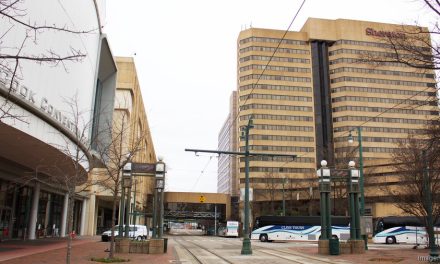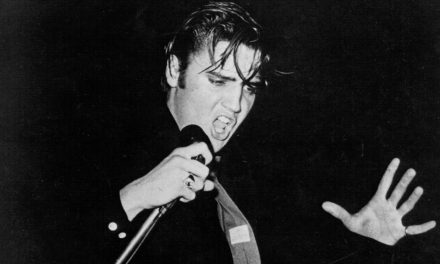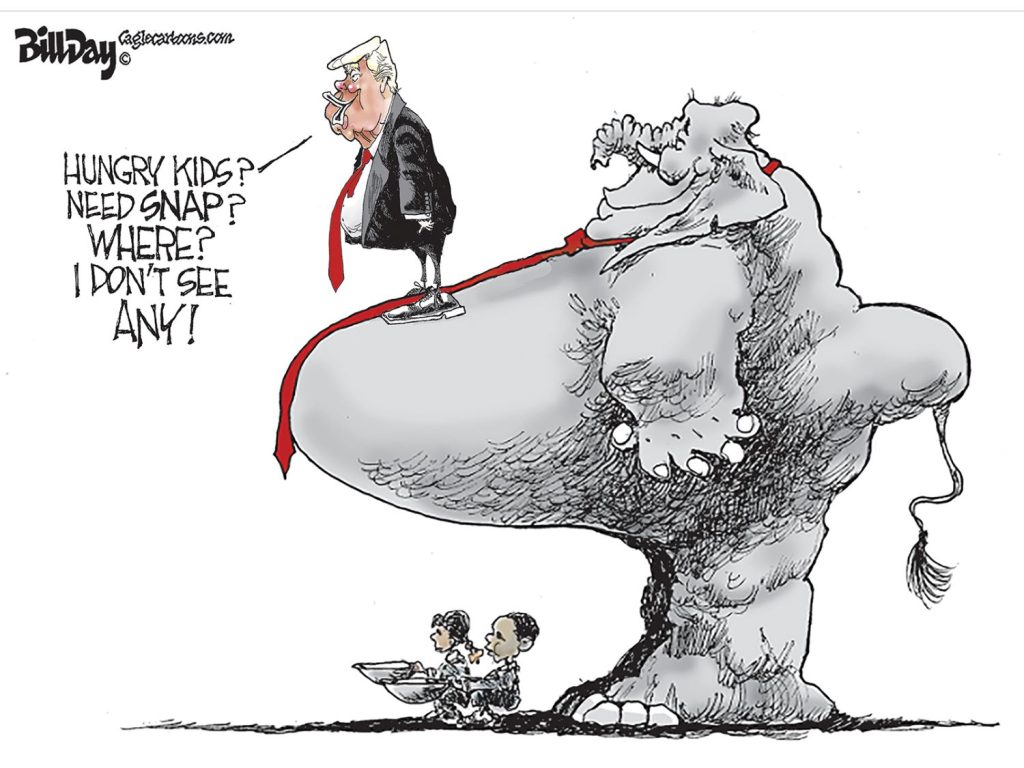Thumbnail: The reopening of Graceland stirs old Elvis memories, meeting Elvis twice, being on the first tour of Graceland, and writing about Elvis’ Jewish connection.
It seems that all of us of a certain age has our own Elvis Presley stories. The reopening of Graceland last week reminded me of mine.
Some friends as teenagers and young adults went to parties at Graceland and others went out with him to the movies or to ride the Zippin Pippin. In those days, it was even possible to be at a stop light and look over and see him on a motorcycle. Seeing him was not a novel experience, particularly in the area of Graceland.
Memphis was his sanctuary, and he clearly loved it. After two years in the Army, he said “someone asked me what I miss about Memphis, and I said everything.”
Almost a year to the day before he joined the army, Elvis Presley in March, 1957, bought Graceland –an aptly named property for a boy raised in a devoutly evangelical church. He paid just over $100,000 (about $1 million today).
It was “out in the county” in Whitehaven, an area that was rapidly changing. In 1950, Whitehaven’s population was 1,311, but by 1960, it had exploded to 13,894, and when Southland Mall opened as the first enclosed mall in this part of the Mid-South, there was no looking back.
Elvis Sightings
Growing up in Collierville, we were most aware of Whitehaven because it was in the same segregated sports league as our high school. Part of the treat in playing in Whitehaven was driving by Graceland, and once seeing him talking to fans at the front gate.
It was about eight years before I would see him again. As a reporter for the Memphis Press-Scimitar covering the sheriff’s office, civil courts, and criminal justice (courts, attorney general, public defender, and pre-trial services), I bumped into him twice as he visited Sheriff Roy Nixon.
It was a simpler time. In those days, there was no need to schedule an appointment or ask if you could come by and talk to the sheriff. Sheriff Nixon was always friendly, bracingly open with news whether it was good or bad, and enjoyed swapping stories. (Disclaimer: I went to work for him when he was elected county mayor. I told him that I didn’t vote for him; he said he didn’t care.)
Elvis was cordial although when he was told I was a newspaper reporter, that pretty much shut down any real conversation and his entourage closed in to protect him. Mr. Nixon had made him a special deputy in 1970 and he was always wanting a higher ranking badge, eventually getting his badge number up to #3. On November 20, 1974, the sheriff issued him a permit to carry a pistol, and he had to come personally to sign the legal documents connected to it.
The second time I met him was at the same place, but on that occasion, he appeared to be under the influence and dressed in something not too dissimilar from a stage costume.
I had a third opportunity to see him but I declined. He was dead, and a former employee of mine, Sonny Mashburn, had been a funeral director who buried Elvis’ revered mother Gladys. He went back to his old employer to see Elvis at the funeral home. He asked if I wanted to go but I declined.
The First Tour
My Graceland story took place on June 7, 1982. It was the first day it opened for public tours, and I was in the inaugural “VIP group” with Presley family and in-laws and dignitaries. I wasn’t supposed to be there, because the invitation was to Mayor Bill Morris, who succeeded Mayor Nixon.
Mr. Morris had a special place in Elvis World. His father and Elvis’ father knew each other from their hardscrabble backgrounds in North Mississippi. Elvis and Mayor Morris were close friends, spending time together in Las Vegas and elsewhere. Elvis presented him with a Mercedes as a gift, which the mayor sold before taking office. After a photograph of them was published following Elvis’ death, it generated a steady stream of letters to the mayor’s office requesting copies signed by Mr. Morris.
On the day of the first public tour, I was sent in the mayor’s place, joining his father, Vester Presley (who usually was found in the guardhouse at the entrance); Elvis’ wife, Priscilla; and other assorted family members. It was a fascinating tour, sparking stories that ranged from fascinating to acrimonious, from good times to remembrances tempered by the grief unlocked in each room.
My final story about Elvis Presley was a result of the research conducted me and my longtime friend and former Memphis Press-Scimitar colleague, Susan Adler Thorp. We were writing the book, Memphis Jewish Community Center: Seventy Years of Jewish Connection, which led to this sidebar about his Jewish connection.
Elvis’ Jewish Connection
Here’s the sidebar:
When the fundraising call for a new Jewish Community Center went out, the response said volumes about the Center’s reputation. There were contributions from philanthropists and business leaders throughout Memphis, and there was even one from a king – Elvis Presley.
Presley’s donation is commemorated on the Center’s wall of benefactors, “Preserving Our Past, Building Our Tomorrow,” located outside of the Center’s board rooms. On the third row under the heading, 1967, it reads:
In Memory of Gladys P. Presley by
Elvis Presley
In 1967, when Presley was thirty-two years old, he donated $10,500 – the equivalent of about $83,000 today – to the building fund for the new Center on Poplar Avenue. The donation granted him a life membership at the Center, which he often used for racquetball matches after midnight, the time of day when he famously enjoyed much of his social life. Elvis would call executive director Ira Steinmetz, who would open the Center for him; however, in Memphis, it was impossible to imagine denying any request from the King, life membership or not.
It has been widely reported that Presley dedicated a room in the new Center in his mother’s honor, although it was actually dedicated to Meyer and Pauline Fortas, parents of “Memphis Mafia” member Alan Fortas, Presley’s lifelong friend and nephew of Supreme Court Justice Abe Fortas of Memphis. The room later was removed as part of a major expansion and renovation.
Disc jockey George Klein said the singer was well-acquainted with the Memphis Jewish community. Several members of the “Memphis Mafia,” Presley’s group of loyal and ubiquitous childhood friends, were Jewish, including Fortas, Klein, Marty Lacker, and Larry Geller.
A Big Mensche
As a seventeen-year-old, Presley’s family lived at 462 Alabama Avenue in The Pinch District, the Jewish-Irish melting pot that was the center of Jewish life in Memphis. From the 1890s to the 1930s, The Pinch was home to the city’s first synagogue, and Memphis’s first business district. The Presley family lived in a two-story apartment building below the family of Rabbi Alfred Fruchter, who sometimes helped the poorer Presley family pay its bills. The Fruchter family also invited their downstairs neighbors to share meals with them on occasion and to join them in their sukkah to celebrate Sukkot, the Feast of Tabernacles.
In a reminiscence, Rabbi Fruchter’s son, Harold, said Presley called his father “Sir Rabbi” and acted as Shabbos goy for the family, turning on the lights and gas stove on Shabbat for the orthodox Jewish family. Rabbi Fruchter was instrumental in the founding of the Memphis Hebrew Academy where he would become principal, and the Academy also would receive a generous donation from Presley. The rabbi’s wife, Jeannette, recounted many years later how Presley loved her challah. When she learned he had died, she said she cried “because one of the biggest mensches I had ever known was no more.”
Today, there is a cottage industry built on the premise that Presley was Jewish based on the faith of his beloved mother’s great-grandmother. Presley’s Jewish lineage was notably advanced in Elvis and Gladys, a 1985 biography by Elaine Dundy, which said Presley’s cousin confirmed that his maternal ancestor, Nancy Burdine Tackett, was Jewish. It is a point of view even celebrated in Israel at the Elvis Inn, a shrine to Presley located just west of Jerusalem in the moshav shitufi of Neve Ilan, which claims the world’s largest statue of the King of Rock and Roll.
Despite his Pentecostal Church upbringing, Presley regularly wore a Chai necklace, a pendant with the Hebrew letters, chet and yod, spelling out the Hebrew word for life. After the Star of David, it is a popular Jewish symbol and it can be seen around his neck in photographs of several concerts toward the end of his life. Sometimes Presley wore both a Christian cross and the Star of David, and CBS News quoted him, “I don’t want to miss out on heaven due to a technicality.” “I’m a searcher, that’s what I’m all about,” he would say in a book by Gary Tillery on his spiritual quest.
Roots
Presley appeared to recognize his Jewish lineage when his mother died in 1958 at the age of forty-six. He designed a headstone that featured both a Christian cross and the Star of David. Mrs. Presley was buried in Forest Hill Cemetery, and her son was interred in the mausoleum there. Following reported attempts to tamper with the graves, both mother and son were reinterred at Graceland’s Meditation Garden. Mrs. Presley’s new headstone lacked a Star of David.
On the sixtieth anniversary of her death on August 14, 2018, the original headstone designed by her son was reunited with Mrs. Presley. It was removed from a crate in the massive Graceland archives and placed near a large Presley family monument. Graceland officials said the first headstone was taken from storage in order to acknowledge Mrs. Presley’s Jewish heritage. With that official confirmation from Graceland curators, it all but puts to rest the debate about Presley’s Jewish roots.
**
Join us at the Smart City Memphis Facebook page for daily articles, reports, and commentaries that are relevant to Memphis

